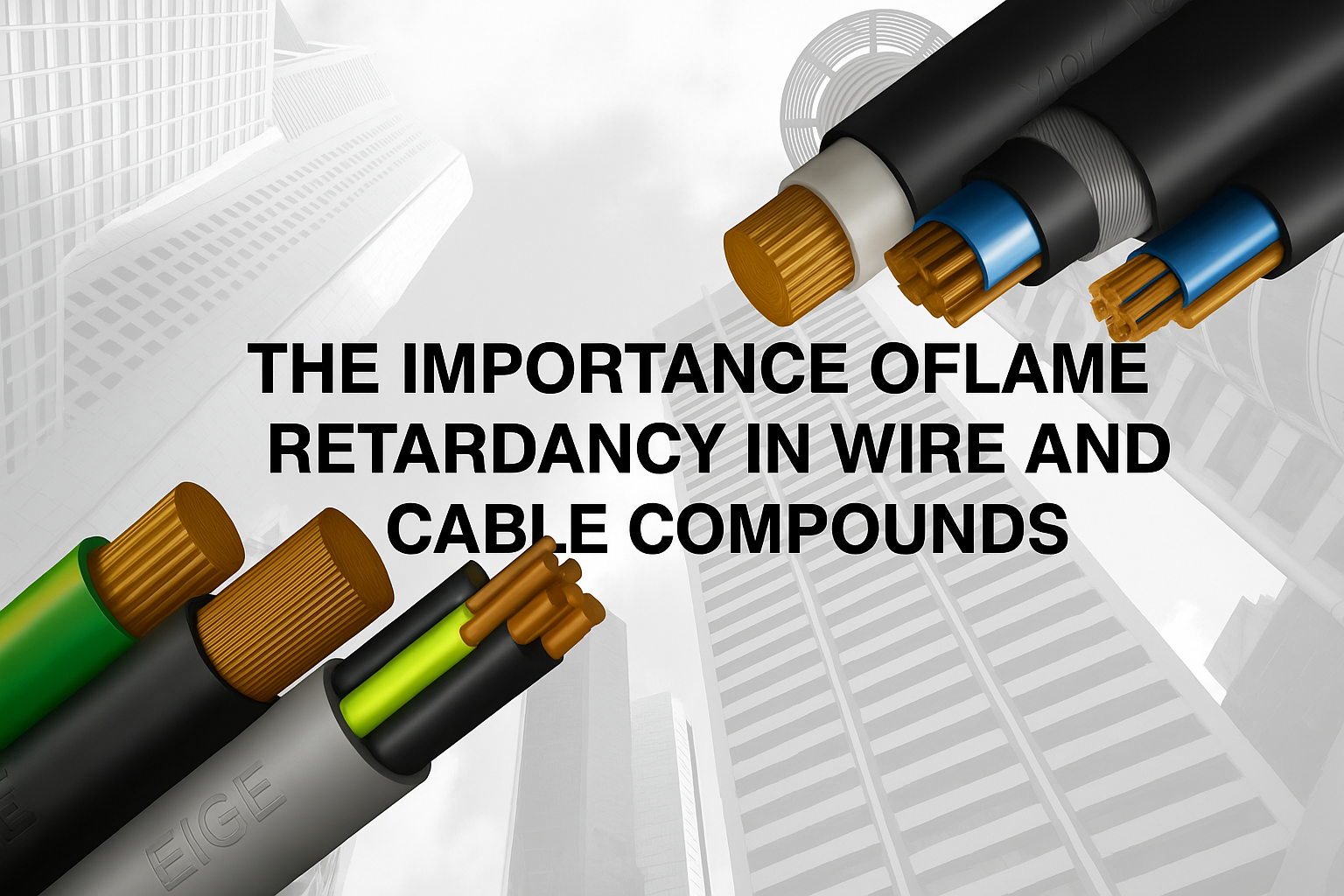The Importance of Flame Retardancy in Wire and Cable Compounds
A single electrical spark can ignite a cable tray and set off a fire in seconds. Without the right compound, cables become fuel.
Flame retardant (FR) compounds prevent that risk. They slow fire spread, reduce toxic smoke, and protect people, property, and equipment. In today's regulated environments—hospitals, data centers, tunnels—FR cable compounds are not optional; they are essential.
This article explains why flame retardancy in cable materials matters and how different FR compounds work at a technical level.
Why Flame Retardant Compounds Are Essential for Cable Safety
Still using non-FR jackets to cut cost? That shortcut could lead to catastrophe.
The Fire Risk in Cable Systems
Cables run through ceilings, ducts, and machinery. When one wire catches fire, it can ignite the entire harness or tray. This is especially dangerous in enclosed areas where smoke accumulates rapidly.
Flame retardant compounds:
- Resist ignition from sparks or overload
- Reduce flame spread along cables
- Limit smoke output and toxic gas release
- Buy time for evacuation and response
Without flame protection, cable fires cause severe damage, system shutdowns, and life-threatening smoke.
Regulatory and Compliance Demands
Codes such as IEC 60332, IEC 61034, IEC 60754, and UL 94 define minimum standards for flame spread, smoke density, dripping behavior, and halogen content.
Typical mandatory zones for flame retardant cables:
- Public buildings and high-occupancy spaces
- Mass transit: trains, tunnels, airports
- Nuclear, defense, and data centers
- Offshore platforms and ships
Insurance companies often require proof of flame resistance. Failures may void claims.
FR Compound vs Non-FR Performance Table
| Parameter | Non-FR Cable | FR Cable with Proper Compound |
|---|---|---|
| Flame Spread | High | Minimal (passes IEC 60332-1/3) |
| Smoke Emission | Dense, black, toxic | Reduced visibility loss, lower gas |
| Equipment Damage | Widespread | Localized, limited |
| Evacuation Time | Short, dangerous | Extended, safer |
| Code Compliance | Usually fails | Passes international tests |
How Flame Retardant Compounds Work in Cable Materials
Wondering how one compound stops a fire while another burns like fuel? It’s all about chemistry and heat control.
Flame retardant systems work through four main mechanisms:
1. Chemical Inhibition of Combustion
Certain compounds release gases that disrupt flame chemistry. Traditional halogenated additives (e.g., brominated or chlorinated systems) release HBr or HCl, which quench free radicals in the flame zone.
Modern non-halogen alternatives, such as phosphorus-nitrogen systems, achieve similar effects:
- Release phosphorus radicals that interrupt combustion
- Form polyphosphoric acids that coat and protect the polymer
2. Char Layer and Physical Barriers
Intumescent additives expand into a foam-like carbon barrier. Others form ceramic oxides.
- ATH (Aluminum Trihydrate) and MDH (Magnesium Hydroxide) decompose endothermically:
- Release water vapor
- Absorb heat
- Form a heat-shielding layer
3. Smoke Suppression
- Phosphorus additives promote carbon retention as solid char, reducing airborne soot.
- Metal hydroxides dilute fuel and smoke precursors.
- Charred surfaces slow down further combustion and keep smoke levels low.
4. Thermal Cooling via Endothermic Additives
Heat-absorbing compounds prevent surrounding polymer from reaching pyrolysis (the point it turns into flammable gas).
- ATH absorbs up to 1.7 kJ/g
- Magnesium hydroxide releases water vapor that cools the surface
| Mechanism | Typical Additives | Primary Function |
|---|---|---|
| Radical Quenching | Halogenated FR, Phosphorus Compounds | Stop flame chemistry |
| Intumescence / Char | APP, pentaerythritol, melamine | Block oxygen and heat with foam layer |
| Endothermic Cooling | ATH, MDH | Absorb heat, cool surface, release water |
| Smoke Suppression | Phosphorus, Metal Hydroxides | Trap carbon, lower soot, clean burn |
Selecting the Right FR Compound for Different Cable Applications
Different applications need different flame retardant strategies:
| Application Area | Key Requirements | Recommended FR Compound Type |
|---|---|---|
| LV Power Cables (Indoor) | LSZH, low smoke, 90 °C rating | ATH-based halogen-free compounds |
| MV Insulation (Outdoor) | Water tree resistance, minimal impurities | Phosphorus + silane XLPE formulation |
| Transit/Rail Cables | HL2 or HL3 (EN 45545), oil resistant | Intumescent + char-forming XLPO jacket |
| Heat Shrink Tubes | Shrinkability, flame class VW-1 | EB-crosslinked XLPO + clean FR system |
| Appliance Cordsets | Thin-wall, 105–125 °C, RoHS | Phosphorus-based low-halogen XLPO |
| Solar PV Wire | UV + flame + temperature cycle | Silane XLPO with ATH + UV stabilizers |
Field Insight: Balancing Cost and Performance
We once tested a phosphorus-based FR system to replace ATH in a thermoplastic LSZH jacket. The material passed UL 1581 VW-1 and IEC 60332-1 with 50% less filler, giving thinner jackets, easier extrusion, and lower cable weight. That change saved material cost and improved flexibility—proving newer FR systems are often more efficient.
Final Thoughts
Flame retardant cable compounds aren’t just code checkboxes—they’re life-saving, system-protecting materials.
Whether you're building cables for hospitals, trains, control panels, or solar fields, the compound inside determines how it performs under fire.
✅ Choose the right FR chemistry for your application
✅ Match it to your smoke, toxicity, and mechanical needs
✅ Ensure it aligns with your processing and cost limits
📌 Need help choosing a flame retardant compound or customizing a halogen-free formulation?
We supply ATH, MDH, intumescent, and phosphorus-based systems tailored for cable insulation and jacketing.
👉 Contact our technical team to request samples or datasheets.

